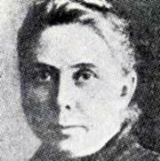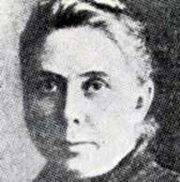
Kata Dalström
Encyclopedia

Västervik Municipality
Västervik Municipality is a municipality in Kalmar County, south-eastern Sweden, with its seat in the city of Västervik....
, Kalmar County
Kalmar County
Kalmar County is a county or län in southern Sweden. It borders the counties of Kronoberg, Jönköping, Blekinge and Östergötland. To the east in the Baltic Sea is the island Gotland....
– 11 December 1923), born Anna Maria Katarina Carlberg in a wealthy upper-class family, became one of Sweden
Sweden
Sweden , officially the Kingdom of Sweden , is a Nordic country on the Scandinavian Peninsula in Northern Europe. Sweden borders with Norway and Finland and is connected to Denmark by a bridge-tunnel across the Öresund....
’s leading socialist agitators and leftist writers of her time. She also wrote books, mostly political texts, but also books about Norse Mythology
Norse mythology
Norse mythology, a subset of Germanic mythology, is the overall term for the myths, legends and beliefs about supernatural beings of Norse pagans. It flourished prior to the Christianization of Scandinavia, during the Early Middle Ages, and passed into Nordic folklore, with some aspects surviving...
and Viking
Viking
The term Viking is customarily used to refer to the Norse explorers, warriors, merchants, and pirates who raided, traded, explored and settled in wide areas of Europe, Asia and the North Atlantic islands from the late 8th to the mid-11th century.These Norsemen used their famed longships to...
legends.
Biography
Kata Dalström was born in to a wealthy family. Politically, Kata Dalström developed from liberalismLiberalism
Liberalism is the belief in the importance of liberty and equal rights. Liberals espouse a wide array of views depending on their understanding of these principles, but generally, liberals support ideas such as constitutionalism, liberal democracy, free and fair elections, human rights,...
, which was radical enough according to her family, towards Marxism
Marxism
Marxism is an economic and sociopolitical worldview and method of socioeconomic inquiry that centers upon a materialist interpretation of history, a dialectical view of social change, and an analysis and critique of the development of capitalism. Marxism was pioneered in the early to mid 19th...
and revolutionary socialism
Socialism
Socialism is an economic system characterized by social ownership of the means of production and cooperative management of the economy; or a political philosophy advocating such a system. "Social ownership" may refer to any one of, or a combination of, the following: cooperative enterprises,...
. In 1893 she joined the Swedish Social Democratic Party
Swedish Social Democratic Party
The Swedish Social Democratic Workers' Party, , contesting elections as 'the Workers' Party – the Social Democrats' , or sometimes referred to just as 'the Social Democrats' and most commonly as Sossarna ; is the oldest and largest political party in Sweden. The party was founded in 1889...
and was the first woman elected to the executive committee of the party in 1900. She was an outspoken supporter of Norway
Norway
Norway , officially the Kingdom of Norway, is a Nordic unitary constitutional monarchy whose territory comprises the western portion of the Scandinavian Peninsula, Jan Mayen, and the Arctic archipelago of Svalbard and Bouvet Island. Norway has a total area of and a population of about 4.9 million...
's right to independence from Sweden, which was proclaimed in 1905. In the question of Women suffrage, she was careful not to be to radical when the question was debated in 1905, because she was afraid that it would delay the reform of male suffrage.
In the party split of 1917 Kata Dalström joined the Left wing, headed by Zeth Höglund
Zeth Höglund
Carl Zeth "Zäta" Konstantin Höglund was a leading Swedish communist politician, anti-militarist, author, journalist and mayor of Stockholm ....
, which would soon become the Communist Party. Kata Dalström was a supporter of the Bolsheviks and the Russian Revolution
October Revolution
The October Revolution , also known as the Great October Socialist Revolution , Red October, the October Uprising or the Bolshevik Revolution, was a political revolution and a part of the Russian Revolution of 1917...
and a Swedish delegate to the second Comintern
Comintern
The Communist International, abbreviated as Comintern, also known as the Third International, was an international communist organization initiated in Moscow during March 1919...
congress of 1920.
One of the controversies Kata Dalström was responsible for within the Swedish Communist group was her view on religion. She wanted to see a more open approach towards Christianity
Christianity
Christianity is a monotheistic religion based on the life and teachings of Jesus as presented in canonical gospels and other New Testament writings...
, which according to her was entirely fusible with Socialism. This view was criticized, especially by the outspoken atheist Ture Nerman
Ture Nerman
Ture Nerman was a Swedish socialist. As a journalist and author, he was a well-known political activist in his time. He also wrote poems and songs.Nerman was a vegetarian and a strict teetotaler...
. Nerman was supported by Zinoviev
Grigory Zinoviev
Grigory Yevseevich Zinoviev , born Ovsei-Gershon Aronovich Radomyslsky Apfelbaum , was a Bolshevik revolutionary and a Soviet Communist politician...
, the leader of the Communist International, who, although a supporter of religious freedom, declared that a communist politician had to be atheist to understand Marxism.
By the end of her life, she became a Buddhist.
In Culture
Kata Dalström appears as a character in Dag Skogheim's novel SulisSulis
In localised Celtic polytheism practised in Britain, Sulis was a deity worshipped at the thermal spring of Bath . She was worshipped by the Romano-British as Sulis Minerva, whose votive objects and inscribed lead tablets suggest that she was conceived of both as a nourishing, life-giving mother...
(1980).

